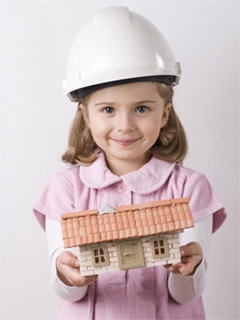A well-thought-out, detailed plan is a must for any kitchen project. Whether you design the kitchen yourself, work with a cabinet distributor or home center, or go to a kitchen designer, formulating a plan is the first step.
There are three basic kitchen functions to consider and arrange to create an ideal kitchen: storage, preparation and clean-up. And the following points will help you sort through those issues.
Typical Kitchen Layouts
For the last few decades, most kitchen designs have been based on three standard layouts: the U-shaped kitchen, the L-shaped kitchen and the galley kitchen
Those all make use of the classic work triangle concept that basically positions the three major kitchen components (refrigerator, stove and sink) in a triangular pattern.
That was determined to be the most efficient layout in the 1950’s, after a research study on kitchen usage showed that most women:
Stayed home during the day
Worked alone in the kitchen
Cooked most foods from scratch
Needed storage space for about 400 items
Tracking Modern Trends
More recently, the National Kitchen and Bath Association (NKBA) co-sponsored recent research that recognized the changing use patterns in the kitchen. It found that most women now:
Work outside the home
Share the cooking
Prepare very few foods from scratch
Require storage space for 800 items
After this study, the NKBA wrote 31 guidelines to provide industry pros with minimum standards for kitchen efficiency, convenience, traffic spaces, distances between items, and countertop and cabinet space.
Multiple Work Centers
Designers now think in terms of multiple work centers or work stations within the kitchen in order to allow more than one person to work efficiently without getting in anyone else’s way.
Work centers are a little less formal concept than a classic work triangle since you can basically create a station anytime decent counter space is provided next to a major appliance or sink.
Adding an island is one of the most common ways to program multiple work centers into a kitchen. It might block the clear paths of the classic work triangle, but an island creates 2-4 small work stations along its perimeter.
These stations can become major work centers if a second sink is added or the cooktop is pulled away from the wall and set into the island. Even without an island, you can create distinct work centers simply by separating the microwave oven and the cooktop/range.
For example, placing them on opposite sides of the sink—setting the microwave near the refrigerator/freezer—provides counter space for food preparation at each appliance.
Finish Materials
Choosing the right finish materials is another critical part of the kitchen remodeling process. Here are some things to consider in five primary categories.
Cabinets:
There are two basic cabinet styles: European-style (frameless) and face-framed cabinets. Either can be ordered from custom or semi-custom cabinet-makers or from stock supplies. Each style has a variety of door, wood and finish options. Cabinets vary in degree of construction quality so look for small details like roll-out and tilt-out drawer features.
Countertops:
Countertop choices range from very durable, yet very expensive materials like solid surface or granite to the less expensive, but attractive choices of ceramic tile and laminates. Solid surface, marble and granite tops are not typical do-it-yourself materials—unlike tile and laminate tops that are definitely within reach of do-it-yourselfers.
Flooring:
Recently, sheet vinyl has been the predominant flooring choice for moderately-priced kitchens. It has a variety of textures, designs, price ranges and has virtually replaced linoleum that was popular in our grandparents’ era. Ceramic tile has always been popular in pricier kitchens, and wood floors are gaining popularity in both moderate and high end kitchens.
Kitchen Sinks:
Kitchen sinks are made of materials such as solid surface, cast iron, stainless steel and plastic. Mounting styles are either top-mount or undermount with a combination of sizes and features: single-bowl, double-bowl, deep or shallow. Faucets offer different finishes: polished brass or nickel, brushed nickel, chrome, stainless steel. Other options and price ranges include pull-out sprayers, single-levers, double-handled.
Appliances:
The main appliance choice involves built-in or free-standing styles. This decision definitely factors into the overall design. In addition, you’ll choose between side-by-side refrigerators or units with top or bottom mounted freezers. Besides the traditional gas or electric issue, range options include: halogen or smooth-top cooktops, double and/or convection ovens, trash compactors, microwaves, range hoods and down-draft vents.
Remodeling Kitchens: Demolition
There’s always some demolition involved in a kitchen remodel. The process usually means removing the old kitchen elements in the reverse order they were installed: 1) Appliances, 2) Plumbing, 3) Fixtures, 4) Countertops, 5) Cabinets.
For many kitchen projects, the demolition also involves re-framing in order to add or remove a door, window or wall. That requires clearing off the wall surface to expose the old framing and perform any necessary structural changes.
Opening Walls
Re-framing will usually impact the home’s structural integrity, so before opening up the walls and attempting any structural changes, be sure to:
Discuss plans with your local building inspection department.
Get all necessary permits.
Follow the relevant building codes.
Schedule inspections as required.
Many communities require permits anytime you open up a wall regardless of structural changes. But the permits and inspections are your assurance that the project will be done safely, and most building officials can help you do the best job possible.
TIP: It’s a good idea to rent a construction dumpster to hold all the debris generated by a kitchen demolition.
Kitchen Demolition
Appliances:
Remove these first to clear space for removing the other elements. Rent an appliance dolly to help wheel out the heavy ones, especially if you’re working alone. If your refrigerator has an ice-maker attachment, be sure to turn the water off before disconnecting the water supply tube in back. And if you have gas appliances, consult a licensed plumber about disconnecting them.
Plumbing Fixtures:
These are basically the sink and dishwasher. First, disconnect any drain and water supply pipes (again, make sure the water’s turned off and have a bucket ready for the water left in P-traps). Dishwashers are usually secured to the countertop or the neighboring cabinets, so remove those screws before trying to slide it out. If the sink is caulked to the countertop, you can free it with a pry bar, but if it’s clipped to the top from below, you’ll have to remove the clips first.
Countertops:
Countertops are usually attached to the cabinets by screws drilled from below through the cabinet framing or special blocking in the upper corners of the cabinets. So before pulling off the top, go into each base cabinet and remove all the screws going up into the countertop. If it doesn’t budge after that, it’s probably glued down so use a pry bar to pull it up.
Cabinets:
When you’re removing cabinets, get the base units out first. That way you’re not reaching up over them when you’re removing the upper cabinets. If you’re dealing with stock box cabinets, they’re usually just screwed into the wall framing and into each other. So removing those screws is about all you have to do to remove the cabinets. But if the cabinets were framed on site and literally built in, you’ll probably have to rip or cut them apart with a reciprocating saw.
As a Design+Build General Contractor, I offer my clients a one-stop shopping approach to all of their home remodeling projects. I work with my clients from initial conception of a project through its completion. Every aspect of the job is managed by me and my professional crew. You will be included in every step of the design process until the final drawings are completed. No detail is left to chance. General Contractor Specializing in Kitchen & Bathroom Design and Remodeling Throughout the Los Angeles area.
Written By:

Offer Steuer
President
OTM Designs & Remodeling, Inc.
For more information you may contact us via email at service@otm1designs.com or you may call us at 888-981-1415. Our website is www.otm1designs.com.


